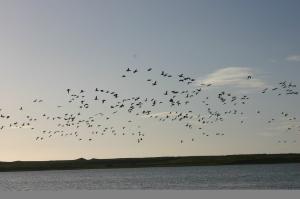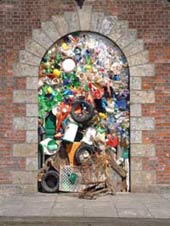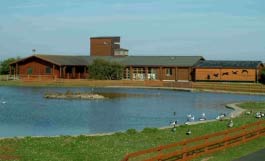Ballyteigue Burrow Nature Reserve
Longitude: -6.659
This site is of international importance because of its range of physical features, such as sand dunes, dune slacks, mudflats and salt marshes.
The site supports four protected plant species:
- Wild Asparagus (see photo),
- Perennial Glasswort (for which this reserve is Ireland's main location),
- Borrer's Saltmarsh Grass and
- Lesser Centaury.
-300x199.jpg)
The rare lichen, Fulgensia fulgens, is found on the site at its only location in Ireland.
The open warm conditions of sand dunes offer a perfect environment for a wide variety of invertebrates such as ants, bees and wasps. An assortment of butterflies and moths inhabit the dunes, including Dark Green Fritillary and Small Heath. A number of noteworthy invertebrates, particularly of the family Hymenoptera (bees and wasps) are found in the Nature Reserve.

The estuary behind the dunes attracts large numbers of overwintering birds including internationally significant numbers of Golden Plover, Lapwing, Black-tailed Godwits, Pale-bellied Brent Geese (see photo).
The mudflats provide a rich feeding ground for waders and the saltmarsh grasses provide grazing for geese, ducks and swans.
The Raven Nature Reserve
Longitude: -6.367
This reserve started its existence as a long narrow sand spit, sheltering the entrance to Wexford Harbour. In the mid-1880's the creation of the adjacent North Slob for agricultural purposes land locked the sand spit on its western side. The site is now part of a major sand dune system, which is largely stable except for the lagoons and sand bar at its southern tip.
Butterflies of Raven Wood - Information leaflet on varieties of butterfly at the nature reserve.
Wexford Wildfowl Reserve
Longitude: -6.416
Owned jointly by the National Parks & Wildlife Service and the Irish Wildbird Conservancy. The area of land owned by Wexford Wildlife Reserve was extended in 1989 by 84 ha. to 194 ha. The Reserve covers only part of the North Slob, the remainder being privately owned farmland. The Wexford Slobs and Harbour are, by their very location and geomorphological structure, a natural haven for birds. Situated on the coast, and in sight of the south east corner of Ireland, it is the closest point to Britain and the continent for birds that are migrating into or out of Ireland from a southerly direction.
Wexford Wildfowl Reserve Information Leaflet


